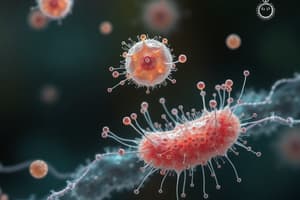Podcast
Questions and Answers
What is the diagnostic stage of Balantidium coli?
What is the diagnostic stage of Balantidium coli?
Trophozoite & Cyst
What is the infective stage of Balantidium coli?
What is the infective stage of Balantidium coli?
Cyst
What is the drug of choice for treating Balantidium coli?
What is the drug of choice for treating Balantidium coli?
Tetracycline and metronidazole
What is the morphology of Balantidium coli cysts?
What is the morphology of Balantidium coli cysts?
What are the two non-identical nuclei present in Balantidium coli trophozoites?
What are the two non-identical nuclei present in Balantidium coli trophozoites?
What is the size range of Balantidium coli trophozoites?
What is the size range of Balantidium coli trophozoites?
Describe the morphology of Balantidium coli cysts.
Describe the morphology of Balantidium coli cysts.
What are the symptoms of chronic balantidiasis?
What are the symptoms of chronic balantidiasis?
How is the laboratory diagnosis of Balantidium coli performed?
How is the laboratory diagnosis of Balantidium coli performed?
What is the infective stage of Balantidium coli and how does it enter the host?
What is the infective stage of Balantidium coli and how does it enter the host?
Study Notes
Diagnostic Stage
- The diagnostic stage of Balantidium coli is the trophozoite stage.
Infective Stage
- The infective stage of Balantidium coli is the cyst stage.
- The cysts enter the host through contaminated food and water, or direct contact with infected feces.
Treatment
- The drug of choice for treating Balantidium coli is tetracycline.
Morphology of Cysts
- Balantidium coli cysts are spherical or oval in shape, and range in size from 40-60 μm.
- Cysts have a thick, hyaline wall and contain a mass of granules and vacuoles.
Trophozoites
- Balantidium coli trophozoites have two non-identical nuclei, a macronucleus and a micronucleus.
- Trophozoites are large, ranging in size from 30-150 μm x 20-60 μm.
Symptoms of Chronic Balantidiasis
- Symptoms include chronic diarrhea, abdominal pain, and weight loss.
Laboratory Diagnosis
- Laboratory diagnosis is performed through microscopic examination of stool or tissue samples.
- The presence of trophozoites or cysts in stool samples is diagnostic for Balantidium coli infection.
Studying That Suits You
Use AI to generate personalized quizzes and flashcards to suit your learning preferences.
Description
Test your knowledge about the characteristics of Balantidium coli, the only pathogenic ciliate and largest protozoan parasite found in the human body. Learn about its morphology, life cycle, and diagnostic stages.




